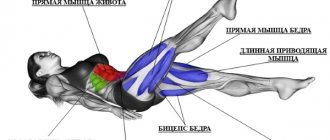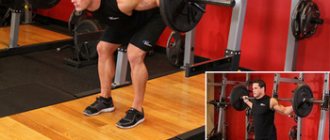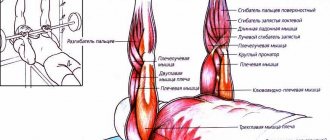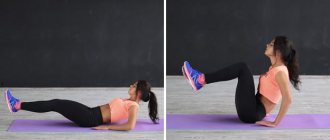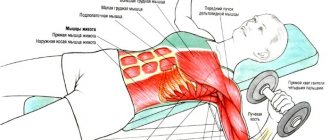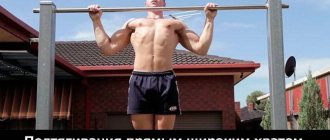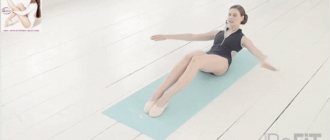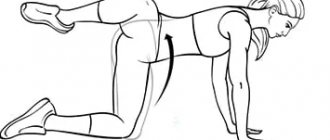Benefits and disadvantages of exercise
The main benefit of the lumberjack ab exercise is that the movement engages almost all the muscles of the upper body. In terms of muscle fiber recruitment, the woodcutter on the block is superior to almost all other movements for working the abdomen.
Main advantages:
- Working out the oblique and rectus abdominal muscles.
- Improves posture by strengthening your core and upper back muscles.
- Ability to perform movements with heavier weights, accelerating progression.
- Ideal for creating “teeth” in the oblique muscles and increasing their size.
- Develops explosive strength and the ability to quickly contract the abdominal muscles (often used in martial arts).
- Equally effective for both beginners and professional athletes.
The exercise does not have any disadvantages. The only possible disadvantage is the lack of mastery of the technique, in which the main load falls on the arms, which makes the movement less useful for the target area.
Techniques and recommendations
First, let's look at a common technique - the “woodcutter” on a block. The exercise uses a crossover simulator:
- Attach the D-handle to the cable of the upper block.
- Grasp it with both palms and take a step back.
- Turn sideways, the cable should be under tension and the weight should be slightly raised.
- Keep your arms straight.
- Exhale and smoothly pull the handle diagonally towards the opposite thigh.
- As you inhale, return to the starting position.
- Do the required number of abductions down, then stand on the other side and repeat.
Recommendations:
- When doing this, keep your back straight and do not lean forward.
- Both phases of the movement must be controlled, avoid sudden jerks down and quick abductions.
- At the lowest point, slightly bend the supporting leg (the one to which you are pulling the handle), and turn the other limb inward on the toe.
- During the approach, keep your abdominal muscles slightly tense.
- When abducting, do not bend your arms. Otherwise, the load will shift from the abdominal muscles to the biceps and triceps.
Perform such a number of rotations on the block that you feel muscle failure at the end of each set. Experienced athletes do 3-4 sets of 12-15 repetitions.
What muscles work
During the classic movement, the load falls on:
- Oblique abdominal muscles.
- Rectus abdominis muscle.
- Transverse muscle.
- Lower back.
Additional burden falls on:
- Lat.
- Deltas.
- Triceps.
- Back extensors.
Side Bend Lunge
This exercise will strengthen the hips and core muscles that have to stabilize the body when bending over.
Execution technique
Stand up straight, hold dumbbells above your head with your arms extended, palms facing each other. Lunge back, placing your knee on the floor. Tilt your body and arms towards your front leg. Return the body to a straight position and, without lowering your arms, return to the starting position.
Repeat the exercise on the other side. Do eight reps on each side.
This exercise feels like a punch to the stomach. The muscles of the arms and legs are also loaded.
Execution technique
Place your hands on the floor and step on the bar of the dumbbell with one foot. Roll the dumbbell under your foot away from your hands while simultaneously bending your other leg and bringing your knee toward your body. Roll the dumbbell back, closer to your hands, while simultaneously bringing your other leg back.
Perform eight times and repeat on the other leg.
This exercise creates conditions of instability. The dumbbell puts you on one side, so in addition to the hips, the core muscles are involved in the work.
Execution technique
Stand next to the jumping pedestal. Take a dumbbell in your right hand, bend it at the elbow, holding the dumbbell next to your shoulder. Step onto the counter with your left foot while simultaneously bringing your bent right knee forward and pressing the dumbbell overhead. Lower to the floor, returning the dumbbell to your shoulder and repeat.
Perform eight times on each leg. When you change legs, switch the dumbbell to your other hand.
This exercise puts a lot of stress on your abs and obliques.
Execution technique
Take the starting position: lie on your back, raise your legs so that they are perpendicular to the floor, hold a medicine ball between your ankles, extend your right arm with a dumbbell in front of you, and place your left arm on the floor. Lower your arm with the dumbbell to the right side and your legs to the left. Return to starting position and repeat.
Do the exercise eight times and switch sides. Now the dumbbell will be in your left hand, and your legs will lower to the right.
This exercise works the arms and core muscles, which tighten to stabilize the body.
Execution technique
Get into a plank position with your hands on dumbbells. While maintaining your balance, perform a dumbbell row with your right hand.
Perform eight times with each hand.
This exercise is often performed with a crossover or medicine ball, but you can also do it with dumbbells.
Execution technique
Place your feet wider than your shoulders and hold a dumbbell in your hands. Turning your body to the right, bring the dumbbell at outstretched arms above your right shoulder. As you turn, your left heel lifts off the floor and your foot rolls on your toe, helping you to better turn your body. Turning your body to the left, move the dumbbell diagonally to your left knee, while simultaneously going into a squat.
Repeat the exercise eight times in each direction.
This is a complicated version of the “Bicycle” exercise, in which not only the abs and legs are worked, but also the arms.
Execution technique
Lie on your back, take dumbbells in your hands. Raise your legs and back straight, keep your hands with dumbbells next to your shoulders. At the same time, bend your right leg at the knee and straighten your left arm. Then bend your left leg and straighten your right arm.
Change legs 16 times, try to keep your back as straight as possible.
Medicine ball fold
This exercise pumps up the abdominal muscles well, and due to the medicine ball, the muscles of the arms and legs are tensed.
Execution technique
Lie on the floor on your back, take a medicine ball in your hands and hold it above your head with outstretched arms, raise your legs to a right angle with the floor. Lift your arms and upper back and hold the medicine ball between your ankles. Lower your legs until the medicine ball touches the floor. The arms and upper back remain raised at this time. Raise your medicine ball legs and pick up the ball again.
Repeat the exercise 10 times.
You can incorporate these exercises into your workout by replacing regular crunches with ab crunches, or perform all eight as a stand-alone core workout.
To increase efficiency, perform the exercises without rest as one circuit. Depending on your capabilities, do 1-3 circles.
Lumberjack exercise on a block
A woodcutter in a crossover is the simplest and most convenient option for any gym. With this option, the load falls evenly on all muscles, and it is also possible to minimize the involvement of the hands in the work.
Technique:
- Attach a rope or D-handle to the top pulley.
- Stand with your side to the machine and grab the handle with both hands. The back is straight, feet shoulder-width apart.
- Begin with a powerful movement to lower the handle diagonally towards your knee or thigh (depending on the length of your arms). Rotate your body using your oblique muscles. To lower the weight lower, a slight tilt of the body is allowed with a straight back.
- Take a minimal pause and at a slower pace return the handle to the starting position.
It is important to understand that the main movement is carried out by the body and core muscles.
Beginners should learn to relax their arms and shoulders as much as possible so that they do not “pull” the main load onto themselves.
Abs training complex for men
1. Abdominal crunches.
2. Vertical and horizontal “scissors”. Lying on the floor, perform horizontal and vertical movements with legs raised 30 cm from the floor.
3. "Bicycle". Lying on the floor and raising your shoulders, as in straight crunches, try to reach the knee on the opposite side with your elbow, while simultaneously pulling your leg bent at the knee towards the elbow.
4. Climber exercise. The starting position is like push-ups. As you inhale, pull your knee toward your chest, and as you exhale, straighten your leg. Then repeat the same with the other leg. Perform at a fast pace for 30 seconds or longer.
Read more: The best protein shakes, how to choose and take them correctly
5. Raising your legs on the crossbar, horizontal bar (if there is no stadium or wall bars nearby at home, then you can lie on the floor).
Reverse lumberjack exercise
Unlike the classic version, the reverse lumberjack emphasizes the upper obliques, deltoids, and lats.
Technique:
- Attach the handle to the lower block and hold it with both hands. Bend down slightly (with a straight back).
- With a powerful jerking movement, move the weight from the bottom position to the top position diagonally. At the same time straighten your back.
- At a slower pace, return the handle to the starting position.
As with the upper block, it is important to feel the load even in the starting position. To do this, you should move half a step away from the machine to ensure tension on the cable.
ATTENTION
• The feet should not rotate during movement;
•The back does not bend backwards at the lower back;
• During execution, additionally strain your abdominal muscles, it should “burn” at the end of the approach;
• Do not turn your body too much when lifting up, the amplitude is not too wide;
• Breathe continuously without holding your breath, inhaling deeply as you rise and exhaling as much as possible at the bottom of the twist.
For variety, you can perform a reverse lumberjack - when the movement is exactly the opposite, for this you need to take the bottom block, move diagonally from the bottom point to the upper opposite corner.
Read more: Squats with a barbell in the Smith machine
Good luck to you, strength and work will grind everything down!
Lumberjack exercise with dumbbells
A woodcutter with a dumbbell is considered a rather inconvenient option, although once you master the technique it can become a worthy replacement for other versions. Unlike a crossover, it puts more stress on the arms and shoulders (which are forced to make an effort to lift the weight or prevent it from falling). Refers to the reverse type.
Technique:
- Hold a dumbbell in both hands and stand straight with your feet shoulder-width apart. Hold the projectile at knee level with your body slightly tilted forward.
- With a quick movement, move the dumbbell in an arc to the level of the opposite shoulder (from the left knee to the right shoulder and vice versa).
- Without pausing, return the dumbbell to the starting position.
It is important to avoid “throwing” the weight down by inertia; this is a key point for correct execution.
You should also be careful not to hit your knee with the dumbbell when lowering the apparatus.
Lumberjack exercise. What, why and why?
I won’t tell you where it came from, but for some reason everyone in the gym loves to pump up their abs. People come to the gym, pay their hard-earned money for a membership and spend the lion's share of time on various abdominal exercises. This approach is not entirely correct, because in a fitness club you need to work with gym equipment - with equipment that you don’t have at home (and we don’t have anything at home :)): barbells, pulleys and cardio machines. As for the abdominal muscles, it is best to work them out at home with exercises using your own body weight. No, in the club you can also do press issues, but in this case, exercise equipment (for which you paid for the use) should be involved in the movements, then it will be a rational waste of money and the right pastime in the gym. In this article we will look at one of the machine-press movements - the woodcutter exercise.
Note: For better assimilation of the material, all further narration will be divided into subchapters.
Muscle atlas
The exercise belongs to the isolated class and is aimed at working the abdominal muscles.
The muscle ensemble includes the following units:
- targeted – oblique abdomen;
- synergists – gluteus medius/minimus, hip adductors, tensor fasciae lata, psoas major, quadratus lumborum, iliocostalis;
- stabilizers - pectoralis major (sternal head), pectoralis minor, spinal extensors, trapezius (lower/middle), rhomboids, latissimus, teres major, deltoids (posterior), triceps (long head), rectus abdominis.
A complete muscle atlas looks like this.
Advantages
By performing the lumberjack exercise, you can expect to receive the following benefits:
- developing the strength of the muscles of the entire press, especially the obliques;
- core muscle development;
- increase in explosive power;
- formation of abs cubes;
- shaping a narrower waist;
- strengthening the back muscles;
- weight loss (under certain conditions);
- improved balance and posture;
- increasing the performance of movements in sports - golf, tennis.
Execution technique
The lumberjack exercise is an exercise of entry-level difficulty. The step-by-step execution technique is as follows:
Step #0.
Go to the crossover/overhead machine and install the single band handle. Stand on the side of the block and grab the handle with two outstretched (up and diagonal) hands, while turning your body to the left. Place your feet shoulder-width apart, bend your knees slightly, and tighten your abs statically. This is your starting position.
Step #1.
Inhale and as you exhale, in one motion, pull the handle down diagonally and across your body towards the opposite leg, rotating your torso as you do so. Keeping your arms and back straight, bring the handle to the bottom when your arms become straight. Having reached the end point of the trajectory, slowly and under control return to the IP. Perform the specified number of times on one side, then change positions and do the same on the other.
In picture form, all this disgrace looks like this.
Variations
In addition to the standard lumberjack version, there are several variations of the exercise:
- with rope handle;
- with emphasis on the knee;
- standing at the bottom block;
- with a dumbbell held horizontally.
Secrets and subtleties
To get the most out of the exercise, follow these guidelines:
- while performing, keep your back straight (don’t let it “walk” back and forth) and your arms straight;
- Place your feet shoulder-width apart or slightly wider, bend your knees slightly;
- use the full range of motion (from the top corner to the bottom corner diagonally);
- Having carried out the downward movement, slowly and under control return to the starting position;
- try to rotate your torso with your legs as motionless as possible;
- make sure that the exercise reminds you of the movements of a woodcutter;
- at the end point of the trajectory (for each side), additionally squeeze the oblique abdominal muscles;
- use different variations of the exercise;
- breathing technique: exhale - when turning the body to the side/down, inhale - when returning to the IP/up;
- numerical training parameters: number of approaches 3 , number of repetitions – 20 (on each side).
We're done with the theoretical side, now let's look at some practical points.
Is the lumberjack exercise effective for the obliques?
The results of a study published in J Sports Med (USA, June 2016 ) on the electrical activity of muscles indicate that the woodcutter exercise greatly contributed to improving the results of specialized athletes - golfers, tennis players. By performing it, they improved their performance indicators: tennis players began to perform a sharper shot, golfers - a longer one.
As for the effectiveness of the exercise in terms of working the oblique muscles, the lumberjack has one of the highest ratings of 8.2 out of 9 on the bodybuilding.com portal among its entire audience, which is the best confirmation of its “workability”.
Will a woodcutter help me burn fat? Is this effective cardio?
It is believed that only running is the most effective form of “aerobics”. But what should those who hate running do with fat? In this case, you should use iron to help you lose weight. Scientists have proven that rapid, rhythmic interval-style strength exercises have the same fat-burning effect.
Lumberjack exercise with kettlebell
The lumberjack with a kettlebell is a great example of proper strength training. The inertia of the projectile allows you to make the exercise analogous to swings, but with an emphasis on the oblique muscles. The main feature of the kettlebell version is which muscles are worked. Due to the weight of the projectile, almost the entire upper body is extremely loaded; this is an ideal option for increasing mass and strength.
The technique is similar to the version with dumbbells, but with the difference that at the top point it is necessary to “dampen” the inertia due to the muscles of the shoulders and hands.
Errors
Here are the mistakes that beginners most often make when trying to improve their abdominal shape.
1. Ignoring complex exercises. Complex training helps to work all the muscles of the body. Therefore, the program includes squats, deadlifts, etc.
2. Working out the abdominal muscles requires a lot of effort and energy, so they are performed last.
3. For cubes, the press is pumped every day, doing it several times. This is true, but the same effect is achieved if you train 3-4 times a week, performing 3-4 sets. There is no point in wasting extra energy.
4. Improper execution. Often, beginners perform movements in a way that is easier for them to do. Such connivance does not bring results and often ends in injury.
5. You cannot neglect the back muscles - they create beautiful posture. The hyperextension exercise works for this.
6. When performing crunches, do not extend much, otherwise the muscles will stretch and the tone of the abdominal wall will decrease.
7. Long-term classes according to the old program, without complications and new exercises. Muscles get used to the load, and at some point the training stops bringing results. As soon as the exercise has become easy to perform, it is complicated, the number of repetitions is increased or replaced with a new one.
8. Relying on devices from TV stores. The products are created for lazy people who still train anyway.
How to replace the exercise
Alas, one movement cannot replace this exercise without loss of effectiveness. This is due to its complex nature. Among the most optimal options for replacement are:
- A combination of lateral and classic twists.
- Combining the regular climber version with a crossover variation (the knee moves toward the opposite shoulder).
- A superset of Roman chair crunches and hanging leg raises (with legs moving to the sides).
Subtleties and secrets
Only at first glance, the “Lumberjack” exercise seems easy to perform. In fact, it should be taken seriously, given some of the subtleties and secrets that professional trainers share:
- To perform correctly, high loads should not be used in the initial stages. The exercise must be done slowly, carefully maintaining the required amplitude.
- When training, be sure to tense your abdominal muscles. The exercise cannot be done in a relaxed state.
- It is important to maintain correct posture; your chin should not rest on your chest when exercising. The head should be kept straight, in line with the spine.
- The movement, reminiscent of an ax swing, is performed along an exact diagonal line. The trajectory is controlled during each approach to the sports equipment.
Breathing plays a significant role in training. You cannot delay it during execution. When lifting, take a deep breath, exhale while lowering the handle of the exercise machine or dumbbell (weight).
Read more:
- Push-ups, what muscles work, types of push-ups, how to do the exercise correctly
- How to properly perform basic exercises for the back muscles
- Exercises on the back of the thigh, pumping the biceps of the thigh correctly
- How to properly stretch muscles - best tips and exercises for stretching muscles and joints
